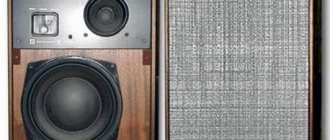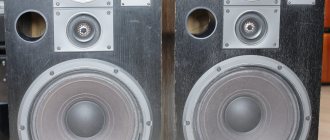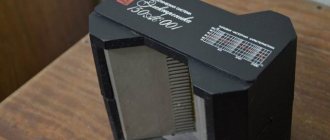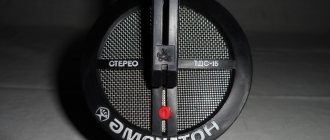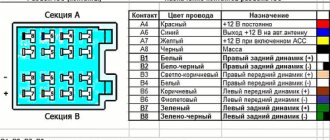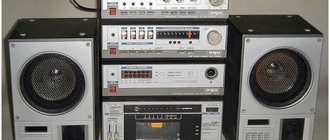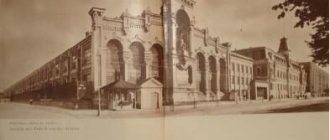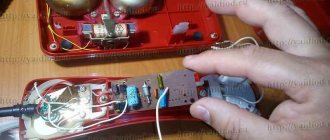Diagram of speakers 35AC-012 or S-90, their modernization to improve the quality of sound characteristics. The S-90 acoustic systems and their analogues, widespread in the 80-90s, were desired by many lovers of high-quality sound reproduction.
The widespread use of high-quality digital audio recording technologies in recent years has led to a revision of the requirements for the remaining components of the sound reproduction path.
In this article, the author shared the results of speaker modernization, showing that even with old (modified) heads it is possible to improve its quality.
The first domestic speaker system that meets the requirements for Hi-Fi equipment (the initial letters of the English words high fidelity - high quality, high fidelity of sound reproduction) was the three-way speaker system 35AC-012 (S-90 series) of a phase-inverted type, which uses 30GD electrodynamic heads -1, 15GD-11, 10GD-35.
On the basis of this model, the acoustic systems 35AC-016 (with a bass reflex), 35AC-018 (with a bass reflex), 35AC-008 (in a closed case), 35AC-015 (with a passive radiator) were created. They all have similar parameters and differ in appearance [1].
Considering that the current market offers a fairly wide range of expensive modern acoustic equipment, but not always of high quality, we will consider options for improving the 35AC-012 acoustic system, released in 1985 by the Riga Radio Plant. A. S. Popov and equipped with new at that time LF heads - ZOGD-2 and MF - 15GD-11A.
For ten years, this speaker was operated with a 2x10 W stereo amplifier, and then carefully stored until recently, when it was modernized.
Schematic diagram
The circuit diagram and arrangement of parts on the filter board, given in the description of the speaker, are shown in Fig. 1 and 2, respectively (element C3 is excluded). Capacitors C1, C2, C4-C7 - MBGO-2, C9, C8 - K73-11. The filter elements are mounted on a board measuring 210x160 mm made of 12 mm thick plywood.
Inductors L1-L4 are installed on the board in a position in which their magnetic coupling can significantly affect the quality of sound reproduction. The filter itself is mounted on the rear wall inside the speaker housing behind the woofer head. Circuit elements marked with the prefix 1 are located outside the crossover board.
Rice. 1. Circuit diagram of speakers 35AC-012 (radio equipment S-90).
Rice. 2. Location of parts on the speaker filter board 35AC-012 (radio equipment S-90).
Refinement of the 35AC-1 acoustic system
Listening to music on my 35AC-1, every day I became more and more tired of their sound. I have long heard about the modification of the speaker system, but for some reason I didn’t pay much attention to it before. But then I decided to try it anyway. After surfing the Internet, I found a lot of information about modifications to the 35AC-212 (S-90) and 35AC-1, and I got down to business.
1. Body. The first thing I did was disassemble the speaker system. I unscrewed the front panel, the dynamic heads, took out the cotton wool, removed the filter and the bass reflex.
Then I strengthened the back wall of the box, installing two slats across the entire body with a thickness and width of 20 mm and a spacer (see photo), closed the holes on the front panel where there was a glass from the mid-frequency head, a high-frequency head and switches. I filled 10mm thick plywood with PVA glue. In place of the glass, I cut out new holes for the midrange and tweeter. (see photo). I placed a plastic cup (similar to the S-90) on the midrange driver, but it is usually better to use a wooden one. Inside, I covered all the walls with 18mm foam rubber (I couldn’t find any felt), but before that I needed to lay the HF and MF head wires under it (I didn’t do this, I was in a hurry). The bass reflex was shortened by 10cm by tuning it to a different frequency (mumbling less) and also covered with foam rubber on top. The box was covered with black lining fabric.
2. Filter. I started by throwing out the tone switches and unnecessary resistors; for this you may need a circuit (it’s not hard to find on the Internet). After that, I moved all the filter parts onto a wooden board made of 8mm plywood. It is not recommended to weld inductors; they must be glued. I soldered all the connecting wires of the filter onto an audio cable (at least the cheapest one). I soldered the wires that lead to the heads directly to the filter and not through each other. For the low-frequency driver, a thick wire is no less than 2 mm2, for the mid-frequency driver, no thinner than 1.5 mm2, and 1 mm2 for the high-frequency head (in the photo, the wires for the midrange and high-frequency heads are thin, I wanted to try it and installed what I had, later replaced it).
The filter was screwed onto the bottom wall of the speaker.
3. Vata. From one sausage that I took out, I sewed a square pillow and threw it on top of the column. On the other I made a small pad (about 0.5 sausages) and placed it on the bottom on top of the filter.
4. Midrange. I didn’t have a midrange driver at all. I installed the 10GD-34 only after finishing it (by gluing a cap made of a tennis ball, I also found an article about this modification on the net), and also closed the windows in the head diffuser holder with foam rubber. I covered the inside of the glass with felt and filled it with cotton wool.
5 . The final part. I soldered the dynamic heads while maintaining the switching polarity. The dynamic heads were screwed through rubber gaskets. I turned on the music and began to enjoy a completely different sound. I myself didn’t believe that my 35AC-1 could play like that. P. _ S. _ I advise you to redo one speaker first so that you can compare the sound of one and another speaker system.
Refinement of the body
First, carefully remove the protective grilles of the heads and the heads themselves, the filter and other elements that limit access to the internal surfaces of the case walls. To improve the sealing of the housing, they coat the joints of the walls and the seats for the bass and midrange heads from the inside with silicone sealant.
If necessary, fill the gaps between the walls with sealant from the outside of the housing, after first cleaning them of dust, dirt and glue. The sealant is used to match the color of the body or transparent.
To avoid staining the veneer trim of the case with sealant, cover it around the cracks with paper adhesive tape and remove excess sealant.
After it has hardened, a sharp knife is used to make a shallow cut along the edges of the tape, where it meets the sealing compound, and the tape is removed. For this procedure it is convenient to use a metal ruler.
Many radio amateurs who modified industrial speakers increased their rigidity by introducing additional stiffeners (bars) and spacers to combat vibration of the panels. To suppress vibrations, the inner walls were covered with a sound absorber.
However, simply increasing the rigidity of the walls or thickening the panels only increases their resonant frequencies and changes the nature of the distribution of vibrations and radiation, therefore, along with such modifications (or instead of them), it is advisable to use materials that have increased internal losses and sufficiently high elasticity.
Materials called vibration damping can be applied to regular panels. Such materials reduce the amplitude of vibrations, so it seems possible to achieve acceptable results with panel thicknesses 1.5...2 times less than required [2].
Therefore, it is recommended to apply self-adhesive vibrating plastic with a thickness of 1.5.2 mm to the inner surfaces of the walls of the housings (used to reduce vibrations of car body parts).
The sound-absorbing coating increases the sound absorption of low frequency vibrations up to 500-1000 Hz. The degree of sound absorption is proportional to the surface area of the coating. If you mount it on the walls of the housing not closely, but at a distance of 20.50 mm, sound absorption at frequencies below 500 Hz increases [2].
The manufacturer of 35AC-012 placed mats with mineral wool in sufficient quantities in the speaker cabinets at some distance from the walls and there is apparently no need to additionally cover the walls with a sound absorber in this speaker model.
To maintain the stability of the speaker cabinet and at the same time avoid the transmission of vibrations from the cabinet to the floor, plastic supports can be replaced with rubber ones in the shape of a truncated cone with a base diameter of 28 and a height of 15 mm.
Another option is possible - using conical spikes as supports. This prevents the spread of unwanted vibrations, but there is a problem of scratches and the need to place under the spikes, for example, patches, a stone slab or other support, which is useful for better transmission of the sound picture: high-frequency speaker drivers should be at the height of the listeners' heads.
The weakest link in this speaker, according to many critics, is the midrange head. Its frequency response has a sharp decline above 4.5 kHz, and the mechanical quality factor is very high - 11.8.
To expand the band, which significantly affects sound transparency in the midrange, you can use the following technique.
Using solvent 646 or 647, the dust cap is soaked and removed, thereby opening access to the voice coil. A dustproof cap with a horn, intended for the 10GD-36 head, with the wall cut to 7 mm, is glued into its upper part using Moment glue (Fig. 3, a). Reducing the quality factor of the head is achieved by acoustic damping.
For the greatest efficiency in suppressing the main resonance of the moving system of the head, damping fabric is placed in the holes of the diffuser holder. For this purpose, eight identical elements are cut out of thick cardboard approximately 2 mm thick (Fig. 3, b). The total area of the holes for the 15GD-11A head should be 22...28 cm2 [3].
One side of each element is smeared with Moment glue. After 5 minutes, glue them onto cotton fabric stretched in an embroidery hoop. After 30 minutes, the fabric is cut along the edge of the elements. The resulting elements of the acoustic resistance panel (ARP) are slightly bent and glued to the windows of the diffuser holder (Fig. 3c).
The gluing areas are additionally coated with glue. It is important that the fabric in the holes of the elements is stretched, otherwise there will be no effect from using the PAS. After such modification of the head, its frequency band was significantly expanded, linearity and, most importantly, the sound quality of the speakers as a whole were improved.
Rice. 3. Fastening the head 10GD-36.
Modernization 35AC
An example of a medium modernization (upgrade) 35AC-012. Year of manufacture 1985, company Radiotehnika . Before the speakers came to me, they had already been “modernized”. The modernization consisted of replacing the HF speaker 6 GDV-7 with a Chinese SG in appearance very similar to our 10GD-35, but only in appearance, which will become clear later when measuring its parameters. For some reason, the HF speaker 6GDV-7 was not connected to the other speaker. The second thing is not standard: the speakers had two woofers from 1978. release, although both are the same, very similar to 30GD-1, but on the basket it says 8GD-1-25. In my opinion, in these speakers only the housings, filters and midrange speakers 15GD-11 on suspensions made of impregnated fabric remained original, which is not so bad.
I took the AC apart. I first checked the speakers and sorted out the working ones from the non-working ones, with the following result: 15GD-11 working ones and the rest non-working ones.
Both LFs turned out to be non-working, one had to be rewound and the lead leads changed, the second one had to change the leads and glue the suspension. The measurements showed good results for the “rare ’34” speakers.
| DC resistance | 6.5 Ohm |
| Resonance frequency | 29 and 29.5 Hz which is very good |
| Sensitivity 1W/1m/100Hz | 89dB I didn't even expect both of them |
Midrange speakers measured parameters
| DC resistance | 6.3 Ohm |
| Resonance frequency | 180 and 200 Hz |
| Sensitivity 1W/1m/1000Hz | 91 and 92dB |
The HF speakers in both had debris in the gap and one had a broken coil, so both speakers had to be repaired and slightly modified.
| DC resistance | 12 Ohm |
| Resonance frequency | 1.0 and 2.9 kHz |
| Sensitivity 1W/1m/10kHz | 89 and 91dB |
The original crossovers were slightly different, as can be seen in the photo by the large capacitors on the left, 4 pieces on the left, 5 pieces on the right. The filters had to be remade for the speakers, although they still need to be remade.
I had to make a filter , or rather from scratch, the speakers are not standard.
Based on measurements of the parameters of these speakers , I calculated and manufactured a filter . For the low-frequency speakers, the filter turned out right away, but for the midrange and high-frequency speakers we had to tinker with the crossover frequencies and matching the output level. Especially with the Chinese HF who didn’t want to play normally. I had to modify it a little more, change the filter circuit and everything was consistent and sounded.
The bass reflex in the speakers had to be cut off, I don’t need a 30Hz lower frequency according to GOST, but 40Hz is enough, which will contribute to the unevenness of the entire frequency range and will be configured correctly.
The inside of the speaker body was covered with centipon.
I changed the speaker connection wires to normal ones (maybe not a super booper).
I assembled everything, screwed on the decorative grilles and measured the speaker parameters.
| DC resistance | 7.2 Ohm |
| Sensitivity 1W/1m/1kHz | 89dB |
| Frequency range at 4dB ripple | 50 – 16000Hz |
| Frequency range with roll off at the edges of the range 6 dB | 30 - 25000Hz |
And now the most important part is listening.
The speakers showed good uniformity in the frequency and dynamic range, high naturalness and naturalness of sound .
- < Back
- Forward >
Comments
1
2
+18 #12 master 02/16/2019 14:15 My respects. When you understand, you need to be more careful! How the speakers are connected, look at a lot of diagrams on the Internet, or more precisely, you need to know the speaker model and who made them. In my opinion, in Riga 012 the midrange was connected in antiphase, in Orbit the midrange and high frequency were connected in antiphase with the low frequency. I select when setting up. How can I tell you in which column there was which filter, I wasn’t even present??? To avoid such incidents, it is better to do it with a specialist, for example me, with measurements and the correct filters. For example, I have not yet made a single pair of speakers with the same filters, since all 35ACs have different speakers and the speakers sound differently.
Quote
0 #11 VICTOR 01/10/2019 01:01 Hello, I pulled out both boards, but now I don’t understand which one from which column? I also have 4 capacitors on one plywood, and 5 capacitors on the other board. Please tell me
Quote
0 #10 VICTOR 01/08/2019 19:00 Hello, please tell me how to connect the wires from the filter to the speakers in the S90 35AC 012 speakers. During disassembly, I loosely attached marks to the wires, as a result, they flew off
Quote
+29 master 01/18/2017 18:39 My respects. What’s the problem, call, we’ll agree, we’ll meet and move on, after 3-4 weeks you listen and rejoice.
Quote
+1 Dmitry79 01/16/2017 22:54 There are 35ACs, there is a desire to rejuvenate them, change the speakers, etc. Ready to pay for modernization
Quote
+12 Mikhalich 05/04/2015 00:00 Currently, I am a happy recipient of this acoustics. THANKS to the Seller and thanks to the Master. For me, the bear to whom Misha danced the “kachucha” at birth, this is the height of perfection THANK YOU!!!
Quote
0 Grimbart 12/22/2014 01:25 8GD-1 - designed for the Victoria-001 station. The Mir receiver was produced by the VEF plant and has nothing to do with the RRP.
Quote
-15 Dmitry Tkachuk 06/01/2014 04:51 Quoting Amir:
The 8GD-1 heads have a very high sensitivity of 90-minimum. It is better to assemble a tube amplifier and power the HF-mid heads from a separate winding of the transformer or even with a separate HF-mid channel. I was very lucky with the 8GD head. It can be used in tube amplifiers. Another option is to use active filters and a three-band amplifier with level controls in the channels on simple microcircuits (that’s what I have).
The 8GD-1 will not work with a tube amplifier - it is too heavy in every sense, including direct, it has a suspension system, although the sensitivity is quite “tube”, 90 dB.
This head is often confused with the “namesake” 8GD-1RRZ from the old Mir radio receiver. Here it is, yes, just right for a tube amplifier Quote -32 Alex 05/22/2014 16:41 Quoting master:
My regards. The speakers are not mine, they were given to the owner. They work with the receiver. Anton is happy and that’s the main thing. Of course, there are many options for using speakers, I agree. I want to say, don’t rush to throw away the old 35AC, 25AC, they can sound like the new model cannot sound. A comparison of the sound of the 35AC and the Dali ikon-7 proves it; the comparison was carried out together with the owner of the Dali; he also could not believe it until he compared and listened to it himself.
Looks like a new product!
It’s very strange, but they compared the 35ac-012 with the Chinese (inexpensive, by the way) cinema speakers Ultimate sym3, and so the Ultimate sym3 outperformed the 35ac-012 many times over, I was surprised! Quote +142 master 01/16/2013 20:40 My respect. The speakers are not mine, they were given to the owner. They work with the receiver. Anton is happy and that’s the main thing. Of course, there are many options for using speakers, I agree. I want to say, don’t rush to throw away the old 35AC, 25AC, they can sound like the new model cannot sound. A comparison of the sound of the 35AC and the Dali ikon-7 proves it; the comparison was carried out together with the owner of the Dali; he also could not believe it until he compared and listened to it himself.
Quote
1
2
Update list of comments RSS feed of comments for this entry
